
 place on the horror genre map in the 1960s, Italy upped its output even more the following decade as the giallo and the gothic
place on the horror genre map in the 1960s, Italy upped its output even more the following decade as the giallo and the gothic  got swirled together with modern supernatural cash-ins on hits like The Exorcist and Rosemary's Baby. To get an idea of how fuzzy those subgenres could be, look no further than the 2025 Vinegar Syndrome Blu-ray set Bloodstained Italy which collects three '70s shockers making their U.S. home video debuts. Previously relegated to dupey gray market copies or Italian-only DVD, they're all fascinating experiments with more than a few surprises up their sleeves.
got swirled together with modern supernatural cash-ins on hits like The Exorcist and Rosemary's Baby. To get an idea of how fuzzy those subgenres could be, look no further than the 2025 Vinegar Syndrome Blu-ray set Bloodstained Italy which collects three '70s shockers making their U.S. home video debuts. Previously relegated to dupey gray market copies or Italian-only DVD, they're all fascinating experiments with more than a few surprises up their sleeves.  after making his name with films like Death Rides a Horse, Tepepa, and Night of the Serpent. The two prostitute murders here are the only real bloody scenes and look like they wandered in from a different film, while the extensive sex scenes don't really seem to be his forte either with the unabashed Mell and
after making his name with films like Death Rides a Horse, Tepepa, and Night of the Serpent. The two prostitute murders here are the only real bloody scenes and look like they wandered in from a different film, while the extensive sex scenes don't really seem to be his forte either with the unabashed Mell and 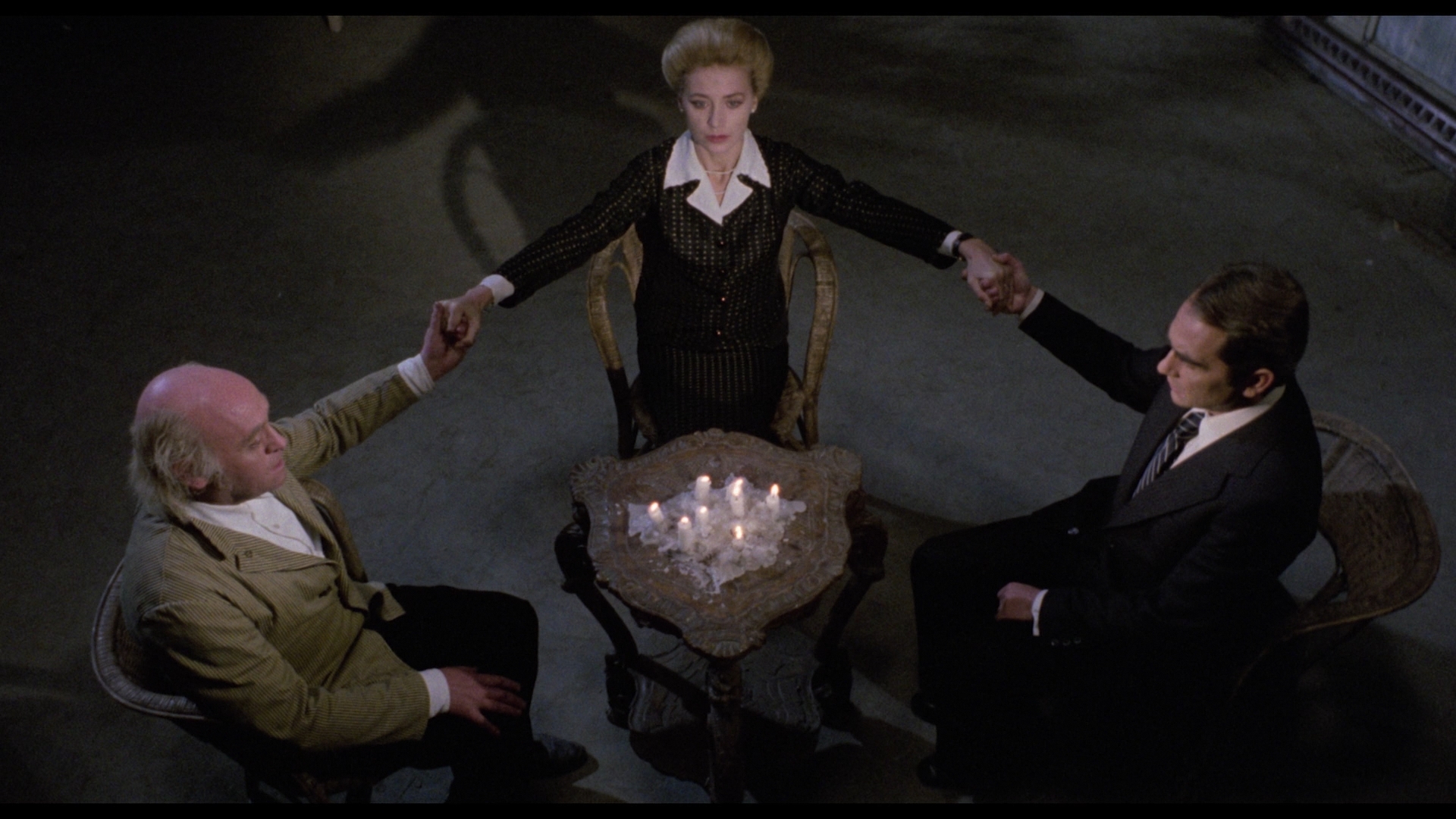 Avram shot from less than flattering angles. The actual horror content is very low and really only kicks into gear during the last ten minutes complete with a graveyard scene reminiscent of The Omen, while Carlo Savina's restrained piano-and-strings score occasionally gets juiced up with some uncredited synthesizer bits. Mell is actually game here and gives a solid performance given how nonsensical most of the characters are, while Israel steals every single second of his screen time with a wonderfully hammy, sinister turn. According to a disclaimer at the beginning of the Vinegar Syndrome release, Petroni disowned the film because the distributor tampered with his original ending-- though the frequently clunky focus pulling that would even make Jess Franco scream indicates there were some issues on the set, too. It's entertaining in a trashy, irrational way though with one or two nifty twists in the third act, and the final scene is actually quite funny if you read it as a commentary on Italian exports to American culture. It would also make a fun double feature with another Italian occult-themed film from '78, the vastly underrated Nero Veneziano a.k.a. Damned in Venice, which tackles a similar idea which more of a direct horror punch.
Avram shot from less than flattering angles. The actual horror content is very low and really only kicks into gear during the last ten minutes complete with a graveyard scene reminiscent of The Omen, while Carlo Savina's restrained piano-and-strings score occasionally gets juiced up with some uncredited synthesizer bits. Mell is actually game here and gives a solid performance given how nonsensical most of the characters are, while Israel steals every single second of his screen time with a wonderfully hammy, sinister turn. According to a disclaimer at the beginning of the Vinegar Syndrome release, Petroni disowned the film because the distributor tampered with his original ending-- though the frequently clunky focus pulling that would even make Jess Franco scream indicates there were some issues on the set, too. It's entertaining in a trashy, irrational way though with one or two nifty twists in the third act, and the final scene is actually quite funny if you read it as a commentary on Italian exports to American culture. It would also make a fun double feature with another Italian occult-themed film from '78, the vastly underrated Nero Veneziano a.k.a. Damned in Venice, which tackles a similar idea which more of a direct horror punch.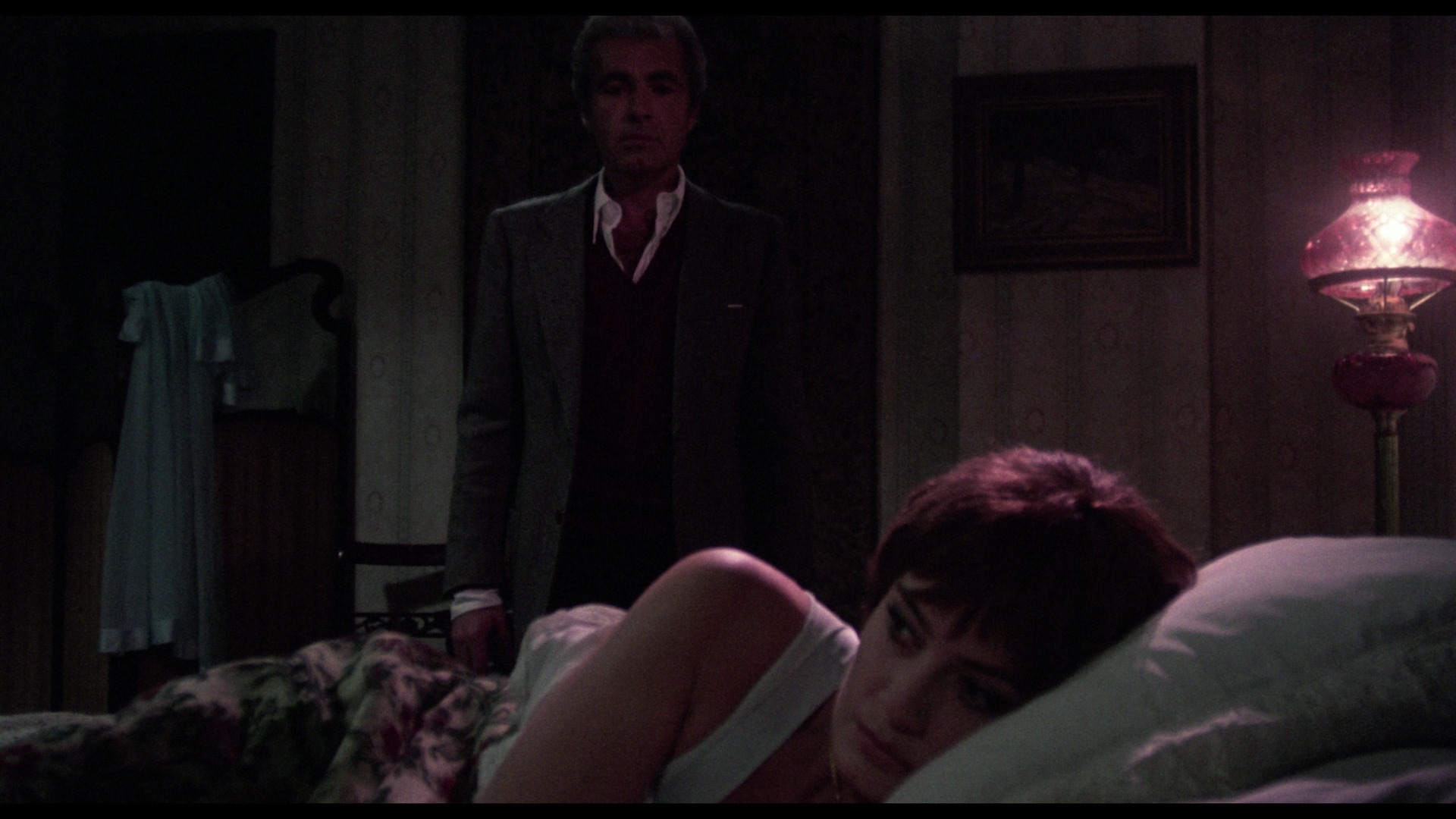 occasional fleeting speck of water damage, and it's definitely a better experience than those bootlegs ever indicated. A new commentary by Eugenio Ercolani (Petroni's grandson) and Troy Howarth untangles the puzzling aspects of this
occasional fleeting speck of water damage, and it's definitely a better experience than those bootlegs ever indicated. A new commentary by Eugenio Ercolani (Petroni's grandson) and Troy Howarth untangles the puzzling aspects of this  film including the background of the director, the state of genre filmmaking at the time, the bumpy production and release process, and the elements familiar from other horror films around the same time. An archival "Disowned Desires" (14m36s) interview with Petroni covers his entry into filmmaking in Fascist Italy, his intention to become a journalist, his memories of key actors during the golden era, and the issues he had with the completion and release of this film despite being pleased with how it generally turned out. In "The End of It All" (21m20s), Petroni's daughter and script supervisor, Silvia Petroni, shares numerous memories from the including working with Orson Welles on Tepepa, and the backstory of the director's wild film right before this one, Lips of Lurid Blue, on which she thought it was ill-advised for him to serve as producer as well. Ercolani himself chronicles the production and disparate elements of the film in "Dissecting the Desire" (44m7s) while contextualizing it within the larger body of his grandfather's work. In "A Controversial Desire" (20m33s), censorship expert Alessio Di Rocco explains why this film is unique among the exorcism films made in Italy, the influence of Rosemary's Baby, the real-life frightening event that altered Petroni's career path, the various casting ideas that didn't come to fruition, Mell's happiness at getting the role during a rough point in her life, some differences in the original script (especially Castel's fate), the false claim that Jess Franco scored the film, and the commercial demands of the time that led to pushing the sex angle here as much as possible. Finally in "A Question of Faith" (11m38s), filmmaker Pupi Avati talks about his own connections to using Satan in his work like Il signor diavolo, the role of the figure in Catholicism and cinema, and the imagery the character inspires in art. Also included are a reel of the alternate material from the Spanish version (13m26s) and the Italian trailer.
film including the background of the director, the state of genre filmmaking at the time, the bumpy production and release process, and the elements familiar from other horror films around the same time. An archival "Disowned Desires" (14m36s) interview with Petroni covers his entry into filmmaking in Fascist Italy, his intention to become a journalist, his memories of key actors during the golden era, and the issues he had with the completion and release of this film despite being pleased with how it generally turned out. In "The End of It All" (21m20s), Petroni's daughter and script supervisor, Silvia Petroni, shares numerous memories from the including working with Orson Welles on Tepepa, and the backstory of the director's wild film right before this one, Lips of Lurid Blue, on which she thought it was ill-advised for him to serve as producer as well. Ercolani himself chronicles the production and disparate elements of the film in "Dissecting the Desire" (44m7s) while contextualizing it within the larger body of his grandfather's work. In "A Controversial Desire" (20m33s), censorship expert Alessio Di Rocco explains why this film is unique among the exorcism films made in Italy, the influence of Rosemary's Baby, the real-life frightening event that altered Petroni's career path, the various casting ideas that didn't come to fruition, Mell's happiness at getting the role during a rough point in her life, some differences in the original script (especially Castel's fate), the false claim that Jess Franco scored the film, and the commercial demands of the time that led to pushing the sex angle here as much as possible. Finally in "A Question of Faith" (11m38s), filmmaker Pupi Avati talks about his own connections to using Satan in his work like Il signor diavolo, the role of the figure in Catholicism and cinema, and the imagery the character inspires in art. Also included are a reel of the alternate material from the Spanish version (13m26s) and the Italian trailer.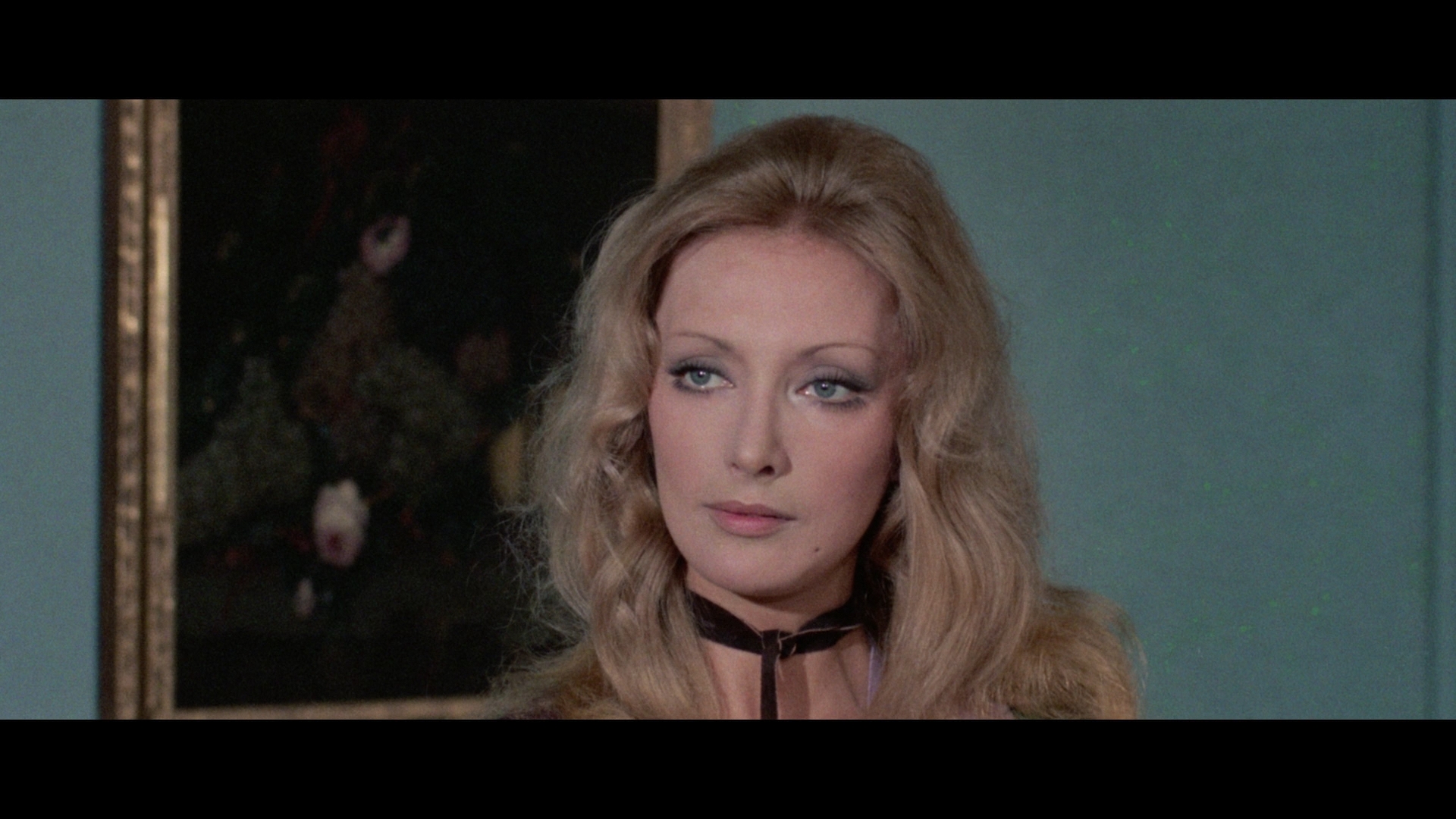 Next on disc two we jump back to 1973 for the
Next on disc two we jump back to 1973 for the  wild genre-mashing The Bloodstained Lawn from arthouse director Riccardo Ghione. This one is very much cut from the same cloth as counterculture vs. bourgeois Italian genre films like Queens of Evil and An Ideal Place to Kill, here dosed with dark humor, eccentric social commentary, and twisted sci-fi, all set to an infectious pop soundtrack by Teo Usuelli. The colorful title would seem to promise another tale of black-gloved mayhem, but what you get instead... Well, things start off with a nocturnal shipping infiltration by a UNESCO agent (Strip Nude for Your Killer's Castelnuovo) who smashes open a bottle of wine to reveal a thick, suspicious red substance. Presumably the next day, Alfiero (Biava) cruises the area around a city where he picks up a streetwalker (Boschero), a kleptomaniac drifter (Marzano), and a dropout couple (Caroli and Willing). He takes them all back to the villa owned by his upper class sister, Nina (The Night Evelyn Came Out of the Grave's Malfatti), and her peculiar husband, Antonio (Tarascio, also from Evelyn), who has robotic oddities both big and small around the house. A goofy drunk (singer Dalla, who also croons the title song) also hangs around with the newcomers as they get ready to crash for the evening, only to find oddities like wine pouring out of the shower head. Sex and pot smoking soon give way to monstrous revelations about what these rich benefactors with outrageous fashion sense really have planned.
wild genre-mashing The Bloodstained Lawn from arthouse director Riccardo Ghione. This one is very much cut from the same cloth as counterculture vs. bourgeois Italian genre films like Queens of Evil and An Ideal Place to Kill, here dosed with dark humor, eccentric social commentary, and twisted sci-fi, all set to an infectious pop soundtrack by Teo Usuelli. The colorful title would seem to promise another tale of black-gloved mayhem, but what you get instead... Well, things start off with a nocturnal shipping infiltration by a UNESCO agent (Strip Nude for Your Killer's Castelnuovo) who smashes open a bottle of wine to reveal a thick, suspicious red substance. Presumably the next day, Alfiero (Biava) cruises the area around a city where he picks up a streetwalker (Boschero), a kleptomaniac drifter (Marzano), and a dropout couple (Caroli and Willing). He takes them all back to the villa owned by his upper class sister, Nina (The Night Evelyn Came Out of the Grave's Malfatti), and her peculiar husband, Antonio (Tarascio, also from Evelyn), who has robotic oddities both big and small around the house. A goofy drunk (singer Dalla, who also croons the title song) also hangs around with the newcomers as they get ready to crash for the evening, only to find oddities like wine pouring out of the shower head. Sex and pot smoking soon give way to monstrous revelations about what these rich benefactors with outrageous fashion sense really have planned.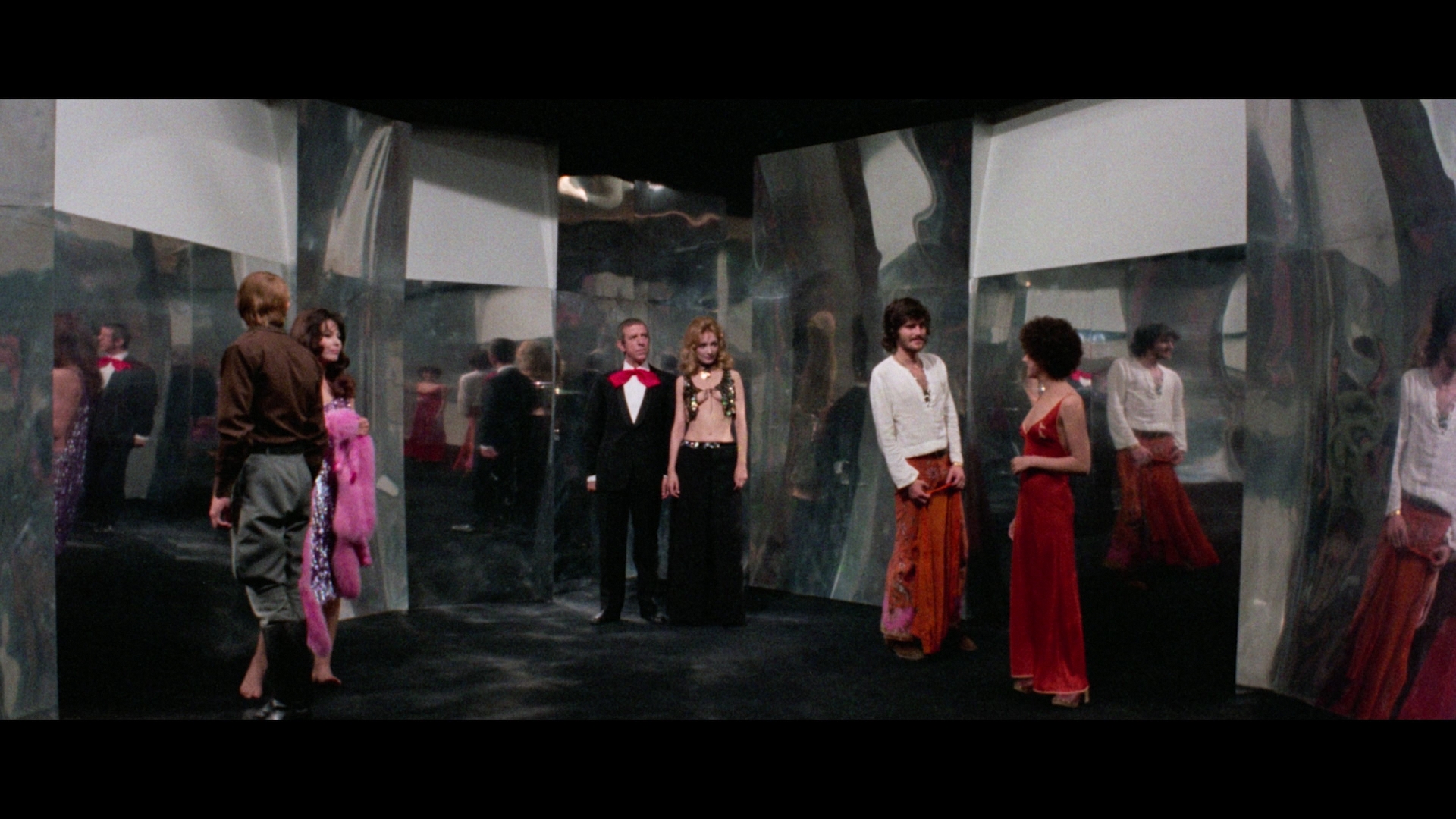 A delirious hangout movie you'll never believe got released to theaters even in '73, The Bloodstained Lawn is a tremendous amount of fun if you go in with an open mind and go along with its groove. It won't be for all tastes to be sure, but the
A delirious hangout movie you'll never believe got released to theaters even in '73, The Bloodstained Lawn is a tremendous amount of fun if you go in with an open mind and go along with its groove. It won't be for all tastes to be sure, but the 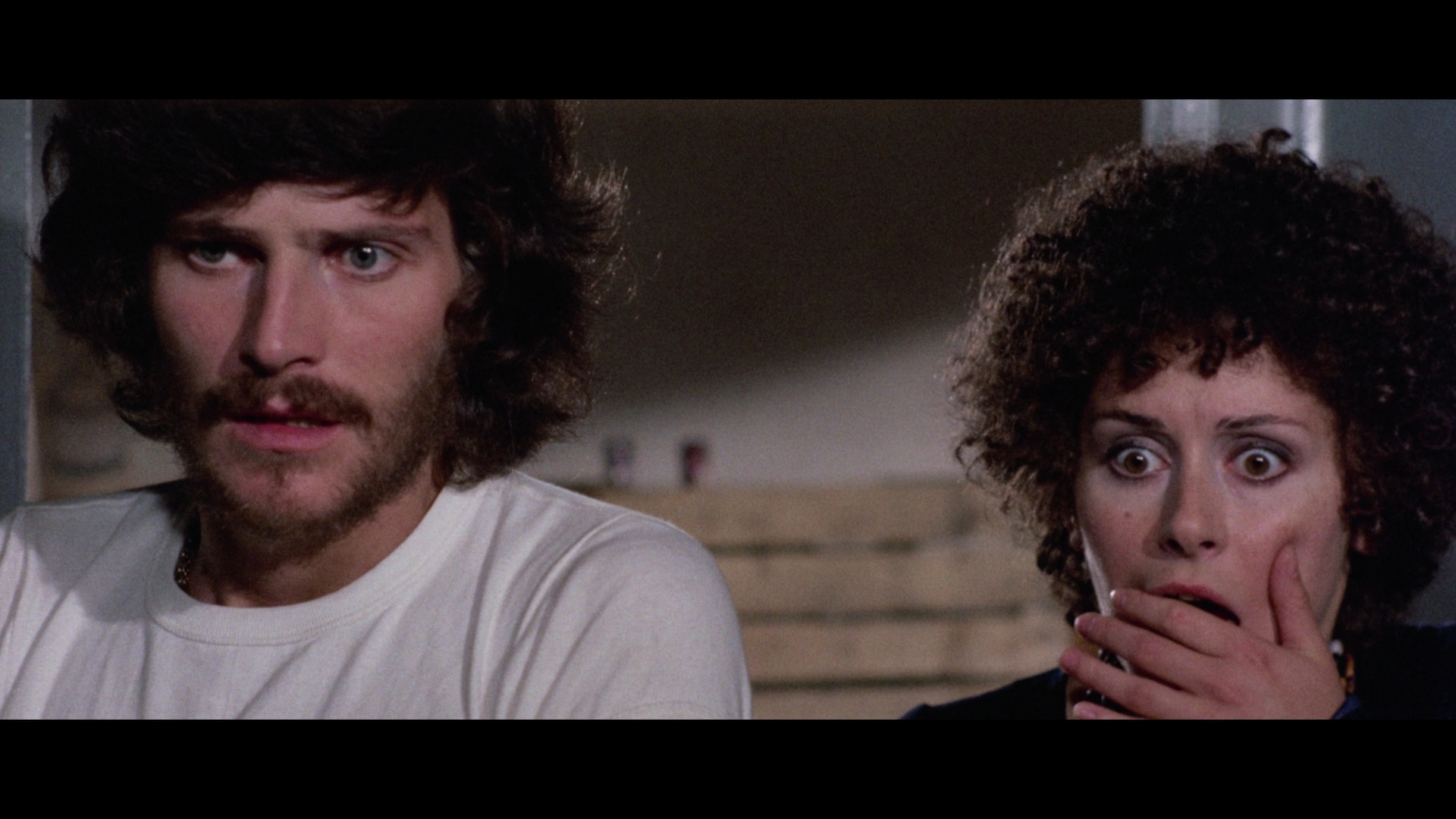 crazy pop art aesthetic and spacious widescreen photography make it a treat for the eyes when you aren't dropping your jaw at what's transpiring. Given the glut of product at the time, it's no surprise this got only minor theatrical play in Italy and had no export value; after that it vanished for a long time until a very dupey, fansubbed version popped up on the bootleg circuit. Eventually an Italian DVD (not English-friendly) appeared in 2017 featuring a nice widescreen presentation, but the Blu-ray is substantially better with a colorful, excellent presentation from a 2K scan of the negative. The DTS-HD MA 2.0 mono Italian track sounds fine for what it is, with optional English subtitles included. This time Rachael Nisbet does the commentary honors with an incisive and well-prepared look at the film's capitalist satire, manipulation of gothic conventions, the original title that changed to the current mysterious one, the director's life and career, and the finer points of this fringe horror curiosity. In "Bloodstained Piacenza" (24m25s), Enzo Latronico surveys the film's primary commerce intersection location and its role in Italian and international films including I Complessi, Fists in the Pocket, Ladyhawke, and Avalanche Express. Then in "Odd Choices" (16m15s), Luca Rea discusses the background of this film, the slippery history of the director after this one including his disappearance from the public eye for a decade, and the clear similarities to another capitalist bloodsucking parable, They Have Changed Their Face.
crazy pop art aesthetic and spacious widescreen photography make it a treat for the eyes when you aren't dropping your jaw at what's transpiring. Given the glut of product at the time, it's no surprise this got only minor theatrical play in Italy and had no export value; after that it vanished for a long time until a very dupey, fansubbed version popped up on the bootleg circuit. Eventually an Italian DVD (not English-friendly) appeared in 2017 featuring a nice widescreen presentation, but the Blu-ray is substantially better with a colorful, excellent presentation from a 2K scan of the negative. The DTS-HD MA 2.0 mono Italian track sounds fine for what it is, with optional English subtitles included. This time Rachael Nisbet does the commentary honors with an incisive and well-prepared look at the film's capitalist satire, manipulation of gothic conventions, the original title that changed to the current mysterious one, the director's life and career, and the finer points of this fringe horror curiosity. In "Bloodstained Piacenza" (24m25s), Enzo Latronico surveys the film's primary commerce intersection location and its role in Italian and international films including I Complessi, Fists in the Pocket, Ladyhawke, and Avalanche Express. Then in "Odd Choices" (16m15s), Luca Rea discusses the background of this film, the slippery history of the director after this one including his disappearance from the public eye for a decade, and the clear similarities to another capitalist bloodsucking parable, They Have Changed Their Face. Somehow the closest thing to a giallo here but also perhaps the weirdest of them all, Death
Somehow the closest thing to a giallo here but also perhaps the weirdest of them all, Death 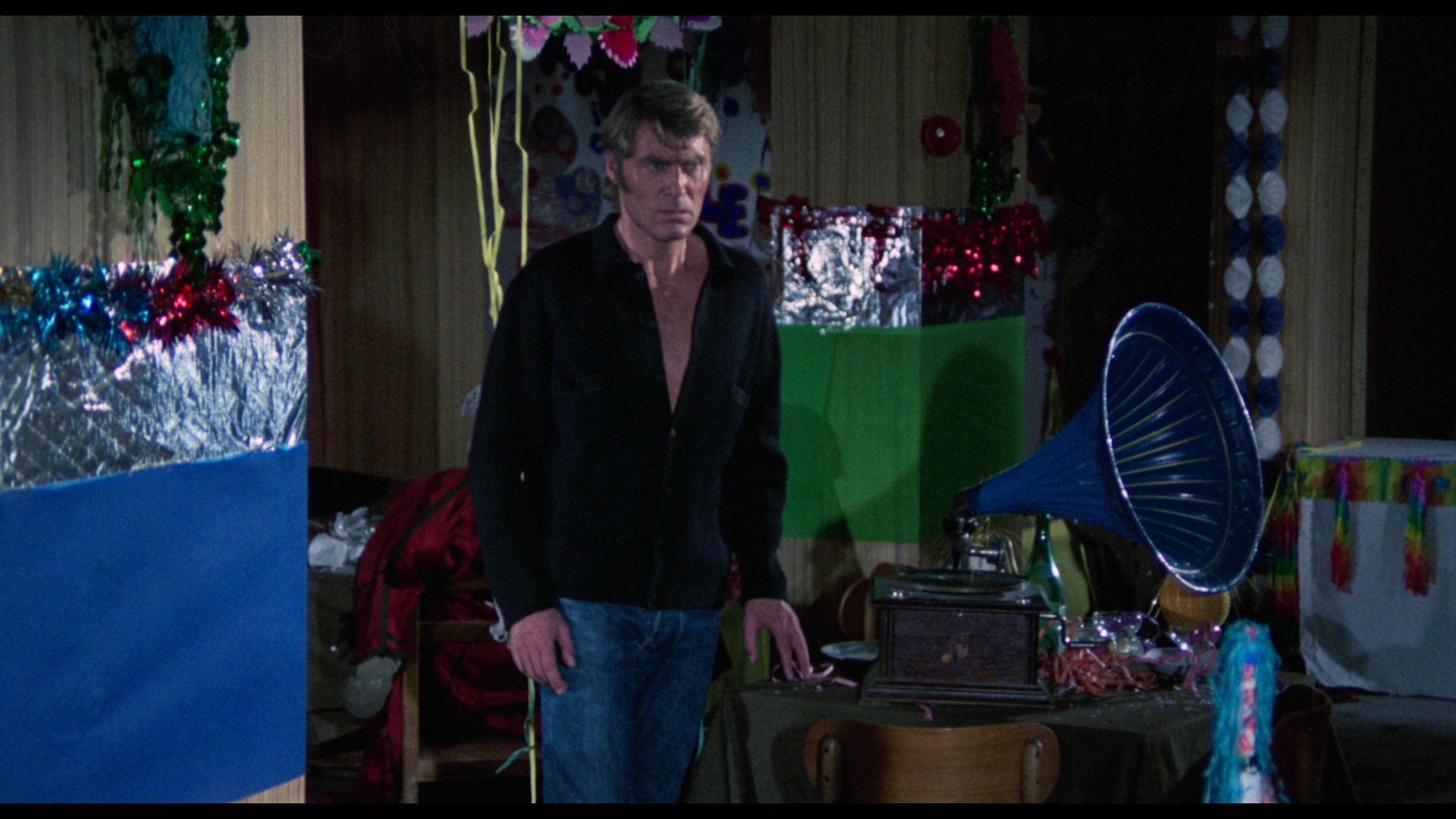 Falls Lightly came out during the heaviest glut for the subgenre in 1972 and has remained a rather obscure crazy footnote ever since. At least for the first half hour or so it seems like a standard murder mystery as mid-level drug trafficker Giorgio (Demons' Candelli) comes home from a trip to Milan only to find his wife murdered. Without a reasonable alibi, he demands help from shady lawyer Savara (early Argento staple Felleghy) who sets him up for a few days inside an abandoned, eighty-room hotel whose owners recently declared bankruptcy. Staying with Giorgio is his mistress, Liz (Amuck!'s Viotti), with whom he has a very volatile relationship that will be tested when they're stuck in the massive building without power and forbidden from being able to go outside or look out the windows. While Giorgio's colleagues in the world of drugs and political corruption figure out how to get him out of this mess, the couple inside the hotel find out the place isn't nearly as empty as they believed -- including the owner (Anelli) who appears to have just killed his wife and wants Giorgio to help dispose of the body. Also around is the owner's daughter (Korosec) who likes to dabble in ritualistic magic. Whether the place is haunted, the couple are going crazy, or something else is going on remains a question until the big twist ending.
Falls Lightly came out during the heaviest glut for the subgenre in 1972 and has remained a rather obscure crazy footnote ever since. At least for the first half hour or so it seems like a standard murder mystery as mid-level drug trafficker Giorgio (Demons' Candelli) comes home from a trip to Milan only to find his wife murdered. Without a reasonable alibi, he demands help from shady lawyer Savara (early Argento staple Felleghy) who sets him up for a few days inside an abandoned, eighty-room hotel whose owners recently declared bankruptcy. Staying with Giorgio is his mistress, Liz (Amuck!'s Viotti), with whom he has a very volatile relationship that will be tested when they're stuck in the massive building without power and forbidden from being able to go outside or look out the windows. While Giorgio's colleagues in the world of drugs and political corruption figure out how to get him out of this mess, the couple inside the hotel find out the place isn't nearly as empty as they believed -- including the owner (Anelli) who appears to have just killed his wife and wants Giorgio to help dispose of the body. Also around is the owner's daughter (Korosec) who likes to dabble in ritualistic magic. Whether the place is haunted, the couple are going crazy, or something else is going on remains a question until the big twist ending.  repeated viewings as the off-kilter approach becomes easier to enjoy without worrying too much about how it all clicks together. More than
repeated viewings as the off-kilter approach becomes easier to enjoy without worrying too much about how it all clicks together. More than  a few folks (including the Blu-ray packaging writer) have compared this to the later The Shining, but there's also a bit of a Norman J. Warren vibe here especially Bloody New Year. The cast is all fine here, with the two leads keeping you engaged despite the unsavory nature of their characters; amusingly given their character names, you also expect Candelli at any moment to bark out his most famous Demons line, "Shut up, Liz!"
a few folks (including the Blu-ray packaging writer) have compared this to the later The Shining, but there's also a bit of a Norman J. Warren vibe here especially Bloody New Year. The cast is all fine here, with the two leads keeping you engaged despite the unsavory nature of their characters; amusingly given their character names, you also expect Candelli at any moment to bark out his most famous Demons line, "Shut up, Liz!"![]()